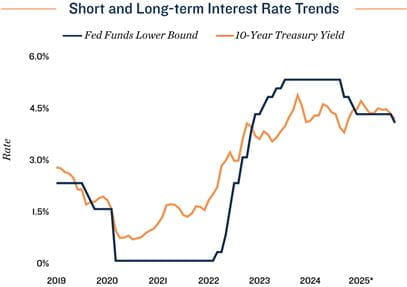Research Brief
Financial Markets
September 2025

Rate Cut May Provide Investors Modest
Relief; Fed Division Hinders Policy Clarity
Much anticipated rate cut comes to pass. At its September meeting, the Federal Open Market Committee reduced the lower bound of the overnight lending rate from 4.25 percent to 4.00 percent. While this was the first rate cut since December 2024, the decision was widely expected by Wall Street. Chairman Powell characterized the change as a “risk management cut” in response to the weakening labor market, shifting the rate closer to a neutral level. The pace of balance sheet runoff, meanwhile, was maintained. Less certain is where the Federal Reserve will go from here.
Fed divisions cloud future for rates. FOMC participants hold differing views on where the federal funds rate should go. While most committee members believe the rate should be under 4.0 percent before the end of December, by 2028, expectations range from that same level down to nearly 2.5 percent. It is clear the Fed generally believes rates should go lower, but they remain divided on how far to adjust. Wall Street’s rate cut expectations, however, have become slightly less dovish after the most recent meeting. The target range most favored by financial markets for September 2026 shifted up 25 basis points to the 3.00 percent to 3.25 percent range. The forward trajectory of rates pose important implications for commercial real estate investors.
 Investors may find themselves with window of opportunity. In the nearer term, September’s 25-basis-point cut, along with potential future reductions, should contribute to lower short-term interest rates. This is reflected in metrics such as the one-month SOFR forward curve, which shows a decline through most of 2026. This could ease borrowing costs for shorter loan terms. For borrowers taking on longer-term debt, however, lenders more commonly benchmark to the 10-year Treasury, the future movement of which is less certain. The 10-year yield has fallen roughly 80 basis points since early 2025 to the low-4 percent band, yet when the Fed previously cut rates from September to December 2024, the Treasury yield actually rose. Higher inflation and the Fed’s own balance sheet run off both add upward pressure to long-term rates. Nevertheless, the recent 10-year yield drop provides an opportunity for more well-priced properties to potentially change hands.
Investors may find themselves with window of opportunity. In the nearer term, September’s 25-basis-point cut, along with potential future reductions, should contribute to lower short-term interest rates. This is reflected in metrics such as the one-month SOFR forward curve, which shows a decline through most of 2026. This could ease borrowing costs for shorter loan terms. For borrowers taking on longer-term debt, however, lenders more commonly benchmark to the 10-year Treasury, the future movement of which is less certain. The 10-year yield has fallen roughly 80 basis points since early 2025 to the low-4 percent band, yet when the Fed previously cut rates from September to December 2024, the Treasury yield actually rose. Higher inflation and the Fed’s own balance sheet run off both add upward pressure to long-term rates. Nevertheless, the recent 10-year yield drop provides an opportunity for more well-priced properties to potentially change hands.
Developing Trends
Inflation an ongoing, but not solitary, concern. Headline CPI rose 2.9 percent year over year in August — up from 2.7 percent the month before — while core CPI inflation held at 3.1 percent. Although commodities prices have been rising since May, the 1.5 percent year-over-year gain last month was not especially elevated, given the broader trade policy context. This suggests the full impact of tariffs have yet to make their way through the market. Ensuring price stability is one half of the Fed’s core mandate, but September’s cut indicates the FOMC is also taking into consideration its responsibilities for the labor market.
Tight housing market persists, aiding multifamily sector. Applications for a home mortgage were up 20 percent in the second week of September from a year ago, reflecting slightly lower rates. Overall ownership barriers remain high, though, and weekly data are volatile. The tight housing market in turn bolsters the value proposition of renting, supporting the rapid recovery in multifamily occupancy in the first half of the year after record new supply in 2024.
4.00% |
4.08% |
|
Federal Funds Rate Lower Bound |
10-Year Treasury Yield |
* Through Sep. 17
Sources: Marcus & Millichap Research Services; Chatham Financial; CME Group; Federal Researve;
Mortgage Bankers Association; RealPage, Inc.; U.S. Bureau of Labor Statistics
TO READ THE FULL ARTICLE

